Rig floor operations grow smarter with evolution in tubular-handling systems
Sensors, AI, cloud platforms and machine vision all working together to enable less manual, more consistent connection processes
By Stephen Whitfield, Senior Editor
In recent years, tubular-handling equipment has proven a fertile ground for bolstering automation capabilities. This equipment is critical for safely and efficiently performing critical functions on the rig – for instance, moving drill pipe from the pipe rack to the drill floor, or making up and breaking out drill pipe connections. A host of systems, like automated catwalks and iron roughnecks, are helping to drive efficiencies in this area.
“The oil industry used to rely on brute force and sheer determination; we would just grunt and get the job done,” said Mark Taggart, Director of Business Development at HMH. “Today, we’re working smarter. We’re designing and using equipment that is intelligent, helping us operate more efficiently and safely.”
Conventional tubular running systems (TRS) typically relies on labor-intensive, mechanical methods prone to data gaps and safety hazards. Original equipment manufacturers (OEMs) view the TRS space as one ripe for transformation, with automation removing the need for people to perform highly repetitive activities. The repeatability of these systems can save time for the driller and the operator, while also removing some of the uncertainty in planning and executing a well.
“The low-hanging fruit with automation is the efficiency, and predictability of future projects is where the value comes,” said Dusty Sonnier, VP of Products and Engineering at McCoy Global. “Whenever you’re planning a well, there’s always this subjectivity on what it’s going to take for you to complete it, but having more confidence in narrowing the window of the unexpected is something that automation can help us with. It greatly reduces that vulnerability.”
In creating these automated systems, OEMs remain aware of the need to keep the human in mind – after all, in most instances they’re still needed in a supervisory role to make sure everything is running smoothly. This means interfaces and remote-control systems must be designed so that they are intuitive and easy to use.
“The design of these systems is something we’re very cognizant of,” Robert Thibodeaux, Director of Casing Technologies at Expro, said, noting that the driller and assistant driller already face information overload at their stations. “We cannot give them another screen to look at and expect them to operate more complex equipment with multiple user inputs. They need to be able to push a button and go.”
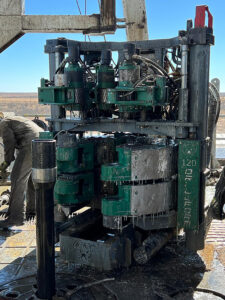
Using sensors and the cloud
Automated tubular-handling equipment is central to HMH’s offerings, highlighted by innovations such as the BD120 iron roughneck and advancements in automated catwalk systems.
Mr Taggart described the BD120, an offering in HMH’s Bulldog series of iron roughnecks, as an integration of hydraulic components, electric components, sensors and programmable logic controllers (PLCs). The hydraulic equipment is the “brute force” doing the hard work, the PLC is the brains of the systems, and the electronics and sensors act as the go-between, providing and transmitting feedback between the hydraulics and the PLC.
To enable automation capabilities on the iron roughneck, HMH installed linear position sensors on every hydraulic cylinder, rotational sensors on the spinner system to count the number of revolutions the pipe has made, and pressure sensors on the tong. Users enter parameters into HMH’s cloud-based software platform – for instance, setting the maximum torque and selecting which auto processes to activate, then hit start.
The software continuously monitors the tool to ensure it stays within those parameters and autonomously recalibrates it if it falls outside those parameters. Effectively, the system mimics exactly how a human would make up a connection on the rig.
“The sensors are giving you the feedback, and the feedback is going to the PLC,” Mr Taggart said. “If you’re going too fast, the PLC sends a signal back to the valve to slow down. That’s the type of feedback that we’re using throughout the machine. All these things are happening in the background while the machine is running, and that’s just one process – you’ve got parallel processes running across the entire program.”
Iron roughnecks such as the BD120 are also designed to integrate with HMH’s larger automated tubular feeding machine (TFM) and catwalk system. The TFM catwalk works in conjunction with a bucking system to make up tubulars horizontally on the ground, and the catwalk lifts these prebuilt stands to the rig floor, where they are either placed into the setback or installed directly into the drill string.
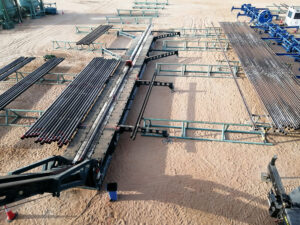
Mr Taggart described the TFM catwalk system as a “triple” catwalk, meaning it can simultaneously handle and deliver three drill pipe stands to the rig floor. As of June 2025, HMH has installed three of these triple systems on land rigs in the Middle East.
“In the past, you had to build all those stands vertically. Now, triple stands of drill pipe are built horizontally, then lifted to the rig floor and racked into the fingerboard,” Mr Taggart explained. “You’re building these on the ground and handing them to the rig floor. The rig can keep drilling while new stands are being prepared. These capabilities allow for greater utilization of the rig to maintain continuous drilling operations.”
The catwalk system is also designed to run double stands of casing concurrently. “Every second casing connection is now made up on the ground and done before it reaches the rig. The rig is no longer waiting on the catwalk – the catwalk is waiting on the rig. In the past, a crew would be off to the side on the rig floor using casing tongs to manually make up casing. During that time, the drawworks would be stopped, and no pipe would be going into the ground; that’s lost drilling time. By assembling casing horizontally and feeding it to the rig floor, we’ve increased rig utilization by up to 50%.”
While HMH has not released performance data for the automated TFM catwalk, Mr Taggart noted that rigs using the system have experienced an average 25-35% decrease in time spent making up casing over the past year compared with the previous year.
HMH is also developing an adaptation of its automated TFM catwalk for jackups, with the goal of automating the use of pipe tubs that hold drill pipe on the underside of the pipe deck. The system would use these tubs much like straw dispensers at a fast-food restaurant, Mr Taggart explained.
The tubs, positioned next to the catwalk and connected via hydraulic and wired hookups, will automatically dispense the drill pipe to the catwalk, which will then feed the drill pipe from the pipe deck to the rig floor.
“These pipe tubs are not new. They’ve been part of the drilling industry for years. What we’re doing is adding a layer of automation so they can be fully integrated into the catwalk. The operator can just sit back as the catwalk automatically delivers tubulars to the rig floor,” Mr Taggart said. He added that HMH has developed a working prototype and is in discussions with several Middle East drillers about conducting potential field trials on jackups later this year.
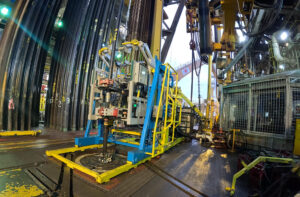
Mixing tongs with AI
Expro has been utilizing automated tongs in its portfolio since 2004, but those systems primarily automate functions that are preprogrammed by a human. The iTONG system features a self-learning functionality that, according to Mr Thibodeaux, takes the human out of the connection process except in a supervisory role. “As long as everything’s going fine, the human is really just sitting back and monitoring the process,” he said.
Upon deployment to well center, the system utilizes a machine vision platform to automatically determine the height of the casing stump being held in the slips. This ensures the tong approaches the well center at the correct height. Determining the correct stump height is critical for ensuring optimal connection makeup by enabling the tong to grip the tubular in the correct position, thereby maximizing connection integrity and, ultimately, ensuring optimal well integrity.
With earlier mechanized and even automated tong systems, users would still have to manually manipulate the tong based on visual recognition of stump height.
“When pipe is lowered and the slips are set, the stump height isn’t necessarily the same every time,” Mr Thibodeaux said. “Operators of a conventional tong system have to adjust the tong vertically every time to make sure it gets a proper bite, which takes concentration and time. That’s one of the first things we had to overcome when designing the iTONG system: If you have an automated piece of equipment, you’re making sure that it’s positioned in the proper location every time. With iTONG, AI identifies the stump height so the system can automatically adjust to the correct height every time to make sure we get that optimal bite during each connection makeup.”
Once stump height is determined, the tong will automatically deploy to the well center, grip the stump and the backing pin, then begin the makeup process.
A collection of encoder sensors and load cells installed on the tong measure turns and torque respectively. The data gathered from these sensors is transferred to Expro’s Datatrek software, where a torque-vs-turn graph is plotted. Using AI and machine learning algorithms, the company’s iCAM (Intelligent Connection Analyzed Makeup) software evaluates the graph data to ensure connection integrity.
Traditionally, torque/turn graphs were evaluated solely by trained, competent and experienced operators. Now the iCAM application gives the operator what Mr Thibodeaux terms a “suggested connection disposition” (i.e. whether to accept or reject the connection), along with a diagnosis and prescribed course of action if the connection is rejected.
“If iCAM spots an anomaly, it will stop the tong mid-makeup, preventing things like cross threading or galling damaging a joint to the point that it cannot be made up successfully on second attempt. It will also evaluate, based on the parameters that it observed and its knowledge of historical data, what the problem was and how to fix it. It does a much more accurate and precise job of evaluating graphs than any human could – even somebody who has been reviewing graphs for 25 years,” Mr Thibodeaux said.
Machine learning algorithms built within iCAM help identify potential anomalies that could occur through a statistical analysis of historical data associated with a given connection type. The application works in either an advisory or active mode. In the advisory mode, the user can override suggested courses of action provided by the application. In the active mode, the app signals its suggested action back to iTONG, which then course-corrects to ensure an optimal connection.
“We’ve been in business since 1938, so we have an enormous amount of connection data,” Mr Thibodeaux said. “We have a lot of digital data that we can take to evaluate all of these connections. That’s really what led us to develop iCAM. That data is valuable in training the algorithms to learn all of these connections, what’s good and what’s bad. As we go forward, with each makeup the system does, it continues to add to that database.”
The iTONG system has been operating since late 2021 in Norway. It was developed in conjunction with an operator working on a high-efficiency jackup in the North Sea that was facing limitations on the amount of personnel it could have onsite due to COVID-era regulations in the country.
In its first six months of operation, the system took part in 22 jobs, during which time more than 1,600 connections were made up. Expro estimates the technology saved the operator approximately 50 hours of rig time per year compared with the previous year of operation, prior to the introduction of iTONG. Further, during initial field trials, the operator saw a 40% reduction in average makeup time.
That success led Expro to expand the system’s reach, deploying it on a second jackup in Norway, followed by a drillship offshore the Ivory Coast in 2023. For the drillship, the company said it saw improved time savings – a 50% reduction in makeup times in the first year of operation compared with the previous year, which was estimated at an equivalent cost savings of $200,000 per well.
Expro said it is planning to expand the fleet drastically through a second round of builds of the iTONG system in 2026, based on proven value for the customer.
“Together with the delivery of the new production systems, we’ll be deploying the next version of iTONG control software, which is further improving efficiency, reliability and repeatability. And thanks to the automation, iTONG produces the exact same high performance every single time.”
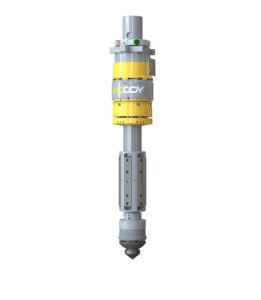
Automating casing running sequences
In April, McCoy Global took a major step forward in automating casing running operations with the commercial launch of its smarTR technology.
SmarTR is a package of several technologies: a hydraulic casing running tool equipped with a link tilt system, dynamic bails and a remote belly pack that enables wireless operation; a flush mounted spider, rotary equipment developed to handle casing using replaceable die carriers and remove the need for manual tongs; and a software platform, which allows users to remotely monitor and control tubular connection makeups without needing to be onsite.
“When you look at casing running, it’s a bit of a symphony of operations from various resources on the rig floor,” Mr Sonnier said. “It’s a guy pulling hand slips, a guy pushing a tong to a driller controlling the rig systems and another resource working on the catwalk. From a bird’s eye view, this system automates that symphony. We’ve applied sensors on all this equipment feeding data on what the position is, what loads are being applied to each equipment, and we’ve got software telling us if it’s the right time to do the next movement or not. By automating everything, we’re also preventing these failure modes that happen when communication in the conventional methodology is not maintained. It’s simplifying the operation.”
The software acts as the “central hub” tying all of the equipment in the smarTR suite together. It uses algorithms to process sensor data coming from each piece of equipment and allows the hardware to communicate with one another. This effectively enables the system to automate the connection sequence.
“The software basically says, you can’t do a certain action unless these things are in their proper position or pressures are in the right range,” Mr Sonnier said. “This information would normally be communicated verbally and visually. I would look across the rig floor and get a thumbs-up from a guy, and there’s lots of potential in that conventional methodology to get that communication wrong. Now, it’s all checked through the system. Each piece of equipment tells the system that it’s in the right state for the next action and allows it to happen.”
Automating tubular running services through products like smarTR are valuable in addressing challenges around skilled labor, Mr Sonnier said, because the system does not require as much individual expertise, or personnel, to run.
“This system doesn’t let you get out of sequence,” he added. “In some of our earlier trials, we would hand the operator the belly pack and train them on control, and they’re running the whole system within a few joints. Conventionally, whenever you’re going out to train an operator on the various pieces of equipment, that’s a multi-week process. When you put a system like this in the hands of a less experienced person, he can’t make mistakes. It makes the human much more confident to take actions, and his ability to build efficiency is much greater.”
McCoy ran the smarTR system in field trials in 2023 and 2024 on four land rigs – two in North America and one each in the Middle East and North Africa. While the company has not published case studies from these field trials, it said that the four rigs saw an average 30% reduction in casing installation time.
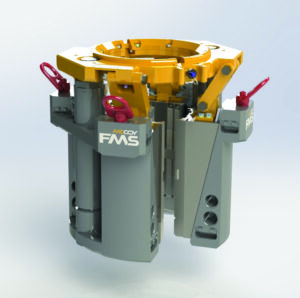
“When you look at the primary driver for those efficiency gains, a significant element was the repeatability. Conventionally, you had the casing crew doing one element of the process and the driller doing a different element at the same time in that sequence. That ballet between the two of them is never perfect, so you lose efficiency and add time. With our system, that sequence is perfect every time, and that produces a repeatable time savings on every joint,” Mr Sonnier said.
On 23 April, McCoy announced the commercialization of smarTR, with its field trial partners awarding a combined $11 million in contract awards.
Next up, the company is looking to add further functionality to the technology. Currently, its automation capabilities are still somewhat basic – the company programs a casing running sequence into the system, and the system operates that sequence. However, there’s no capability for the system to create its own sequences or adapt a sequence to changing conditions during casing running.
“The best way to describe the automation is that we’re recording basic macro sequences. We looked at how our partners were doing this process over the first set of joints in the initial part of the casing running job and then replaying that sequence. But as we went into different markets, we saw those sequences are different. How do they perform these operations in different regions? Capturing the different dynamics of these markets, the different approaches for running casing, is probably the largest challenge right now,” Mr Sonnier said.
The company aims to continue building algorithms that will enable these functionalities and trial them with partners over the coming year. Mr Sonnier said he believes the system will be capable of full automation within two years. DC




